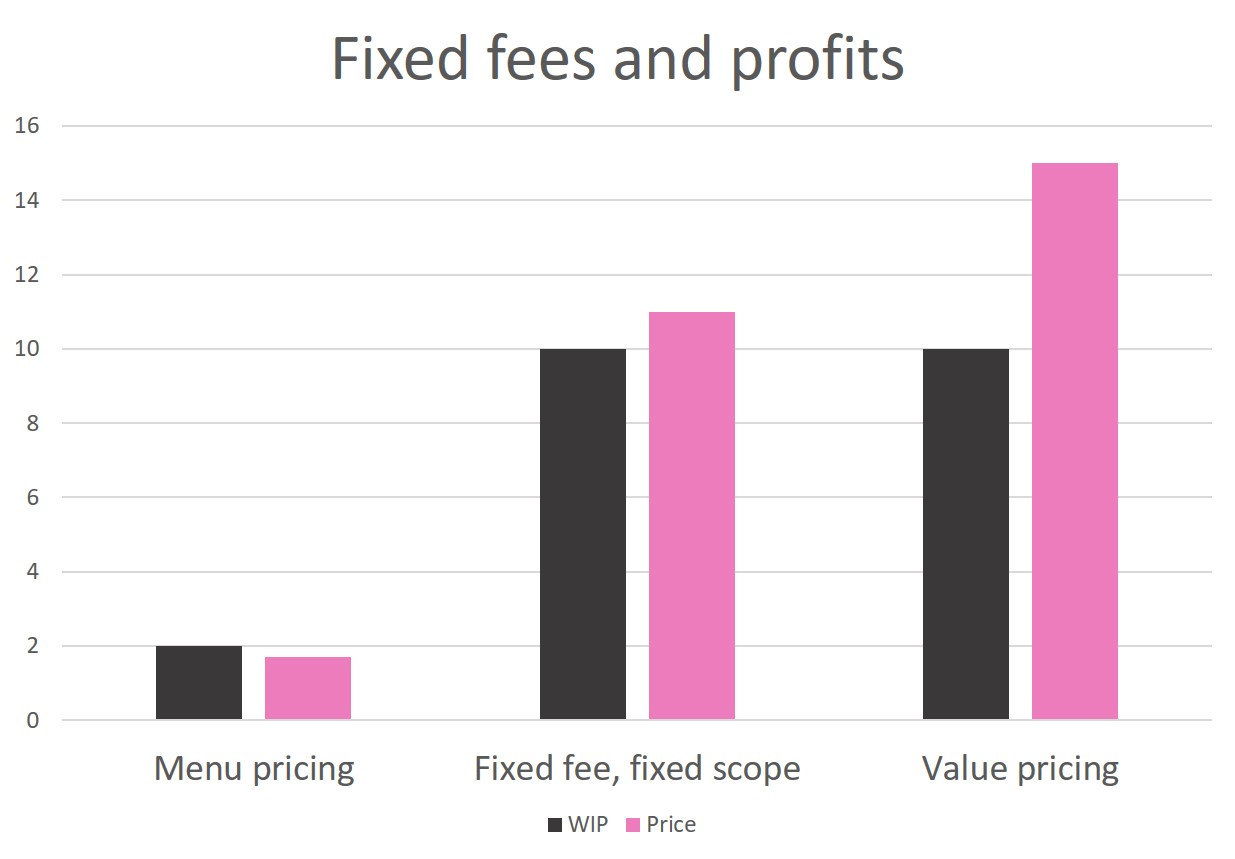27 Apr Fixed fees and underpricing: seller beware!
Offering fixed fees should not be seen as a cure-all for the silliness of under-pricing!
After my last blog on low-balls and low costs estimates, I received a number of responses advocating the use of fixed fees. I’m a big fan of some fixed fees (proper value-pricing), but there are different varieties and they can actually lead to poorer (lower) pricing if you are not careful.
Let me explain.
Time-costing, for all its faults, does actually apply some discipline to the estimating process: solicitors should feel at least some pressure to ensure that the price is accurate and that it exceeds the costs of production. Without the discipline of time-cost as a guide, solicitors can focus on one or more of the following strategies:
- value pricing – pricing according to the client’s perception of value after you have communicated / sold this value
- market rate
- what they think the client will accept
Value pricing is a bit of an art-form and relies not only on building your pricing power (through differentiation and positioning, trust etc.) but also your personal sales and communication skills. If solicitors lack confidence here, they default into all the defensive beliefs and behaviours that lead to under-pricing – but now without the time-cost discipline.
Offering a fixed fee based on a perception of the market rate is particularly dangerous. Pitching yourself at the market rate suggests you are offering the same commodity as the rest of the market (harming any efforts to differentiate and position yourself), and automatically negating the opportunity for premium fees and super-profits. I also find that solicitors routinely under-estimate what the ‘market rate’ is – because they hear more about, and are more sensitive to, lower prices rather than higher prices.
Different types of fixed fees
I like to split ‘fixed fees’ into 3 varieties:
- Menu pricing: fixing the price to the product and offering everyone the same price. Will $250 / Will plus EPA $370. Do you want fries with that?
- Fixed fee, fixed scope: fixing the price to the specific client and matter but limiting your profit risk by detailed scopes and staging
- Value pricing: fixing the price to the specific client and matter – but based on the client’s perception of value and offering a broad scope, genuinely accepting pricing risk.

Menu pricing is most likely to lead to under-pricing. By giving the same price to everyone, you are basically admitting that you are offering a commodity. Menu-pricing has led to a cost-competitive ‘race to the bottom’ for areas such as conveyancing and wills (with commercial leases following) as firms look to match or beat perceived market rates. In many instances, this menu pricing leads to prices not just below equivalent time-costed WIP but below the costs of production.
By offering fixed fee, fixed scope prices, solicitors are trying to reduce their pricing risk – but surely this misses the point: the whole idea of fixed fees is to transfer costs risk from the client to the practice. By detailed scoping and conservative staging the practice effectively transfers all the pricing and profitability risk back onto the client – and where’s the value in that? The price is still essentially based on costs of production and with no pricing risk transfer, there is little opportunity to price the risk and charge premium rates.
Even with minimal pricing risk transfer, solicitors should still offer their fixed fees at a small premium (10-15%) on an equivalent time costed estimate, but more often than not they miss this opportunity through the same poor confidence and defensive pricing behaviours that affect time-costing.
Value-pricing offers the best opportunity for premium pricing and super profits. Here, with pricing power and the right communication skills, solicitors can really sell the value of their work in terms of how it benefits the client, not how long it takes or how much it costs the solicitor. Clients value outputs, not inputs – and solicitors need to talk their language before charging premium rates.
The other benefit of real value pricing is in pricing the risk.
By offering a broad scope value price (without excessive scoping and staging), solicitors are accepting the significant profitability risk that the matter is more difficult than they anticipate and that costs might accelerate beyond expectations. Accepting this risk delivers significant value to the client – value they are willing to pay for, but which solicitors are slow to charge for.
I’m talking about pricing the risk. Clients are willing to pay significant premiums on time-costed estimates to ensure that the price does not get to unaffordable levels. Premiums of 40% or more can be charged, but solicitors seem reluctant to do this. Yes, the legislation and costs-assessment regime are not friendly to value-pricing, but provided you get clear agreement from the client as to the nature of ‘the deal’ in terms of charging for this risk, you are on solid ground (and supported by consumer law). Pricing the risk is the big opportunity that comes with value pricing and a failure to premium price accordingly is a lost opportunity. Silly!
Ultimately, fixed fees can either lead to better (more assertive) pricing or can actually lead to more defensive behaviours and lower prices. It depends on your strategy and your skill. The first step is the changing of mindsets and the development of pricing and sales skills.
Happy pricing!




Sorry, the comment form is closed at this time.